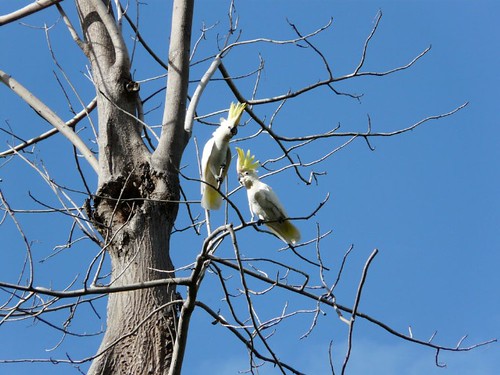tags: parrots, endangered species, conservation, birds, ornithology, Indonesia
Masakambing (Abbott's) yellow-crested cockatoo, Cacatua sulphurea abbotti at Sukun tree.
Image: Indonesian Parrot Project, summer 2008 [larger view].
I had the most fascinating telephone discussion with Bonnie Zimmermann, Vice President of the Indonesian Parrot Project, about the recent reported rediscovery of several individuals of the rarest cockatoo in the world. This species, known as the Masakambing (Abbott's) yellow-crested cockatoo, Cacatua sulphurea abbotti, is a subspecies of Yellow (Sulfur)-crested cockatoo, which are endemic to several small islands of Indonesia. Worldwide, five cockatoo species are critically endangered -- four of which are yellow-crested cockatoos that are found only in Indonesia. Last seen more than twenty years ago when the total population numbered between roughly five and ten individuals, these birds have remained enigmatic due to their rarity and to the immediate threat of extinction.
Under the guidance of Dr. Stewart Metz, President and Director of the Indonesian Parrot Project, volunteers of the USA-based Indonesian Parrot Project teamed up with Konservasi Kakatua Indonesia to send an expedition to the Masalembu Archipelago in June and July of 2008 to search for this rare bird. The team, led by Indonesians, Dudi Nandika and Dwi Agustina of Konservasi Kakatua Indonesia, meticulously surveyed the small Indonesian island of Masakambing and identified ten Abbott's cockatoos. These ten birds, remnants of huge flocks that once filled the skies, include four males, four females, and -- fortunately -- two juveniles. However, this small group of parrots have the dubious distinction of being named the most threatened cockatoo in the wild as well as one of the world's rarest birds.
In addition to rediscovering these parrots, the team spent time photographing and filming them eating, playing with twigs, examining nest holes, mating, and preening. The team reports there are two major threats to this cockatoo's continued survival in the wild: the pet bird trade and logging. Due to their rarity, these birds are highly prized pets among selfish and corrupt government officials who seek to enhance their own social standing by keeping endangered birds.
Masakambing (Abbott's) yellow-crested cockatoo, Cacatua sulphurea abbotti.
Image: Indonesian Parrot Project, summer 2008 [larger view].
The other threat to these birds' continued existence in the wild is logging and the resulting habitat destruction. Cockatoos nest in holes in large kapuk trees, Ceiba pentandra, and mangroves, Avicennia apiculata -- the very same trees that are being cut and shipped to other countries for lumber. After these trees are removed, they are replaced with fast-growing coconut palms, which prevents the native trees from reclaiming their former areas.
In recognition of its critically endangered status in the wild, this cockatoo subspecies is listed as "Appendix I" by the Convention on International Trade in Endangered Species (CITES), an international treaty designed to limit or stop international trade in wild animals and plants when this trade threatens their continued survival in the wild.
According to Zimmerman, immediately upon discovering these birds, the team notified the local police and public officials of the island, and began developing strategies for preserving this remnant population of parrots from further exploitation. Police and officers from the armed forces were taught about legal protections already in place nationally and internationally and were encouraged to conserve the birds. Further, plans are underway to update local laws to protect these birds and to extend these protections to all the islands of the Masalembu Archipelago, where they are more likely to be enforced.
The team of volunteers also are working with local schools and with the students' parents, to teach the basic principles of conservation, to increase public awareness of the plight of these birds, and to foster local pride in this rare and unique parrot. T-shirts are being distributed that reinforce these messages and stickers will be displayed at suitable locations.
Other conservation strategies that have proven successful in the past that might be used on this island include: paying the villagers for each cockatoo that successfully fledges; hiring local villagers as "wardens" to protect the nests from disturbances; protection of remaining habitat; increasing knowledge about the biology of the bird through ecological research studies; holding town meetings for informational and awareness purposes; and providing artificial nestboxes for breeding.
The most aggressive strategy under consideration is initiation of a captive breeding program. In this situation, attempts would be made to identify and breed any captive C. sulphurea abbotti that live outside the island or in zoological parks. All resulting chicks would then be used to repopulate the tiny island of Masakambing.
Considering the critical status of this cockatoo, I sincerely hope that the Indonesian Parrot Project is successful.
Sources:
Indonesian Parrot Project press release.
With very special thanks to Bonnie Zimmerman!
- Log in to post comments




I saw the PBS parrots of Oz program and learned two things about cockatoos, one now forgotten. The other: most (all? it's already slipping away) cockatoos are left footed. fading out, rb
With Stewart Metz on the case, you can be sure it will be successful.
"This species, known as the Masakambing (Abbott's) yellow-crested cockatoo, Cacatua sulphurea abbotti, is a subspecies of Yellow (Sulfur)-crested cockatoo..."
If it's a subspecies, it cannot also be its own species.
Gorgeous bird! It's heartwarming to get good news for a change...
cockatoos are the most beautiful birds in the world especialy the palm cockatoo and the umbrella cockatoo